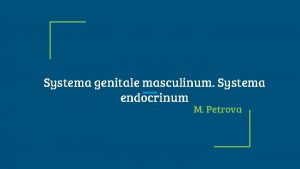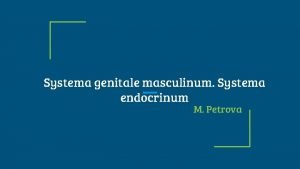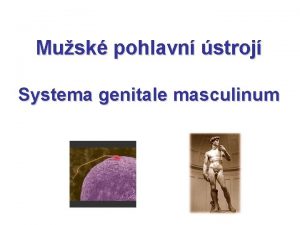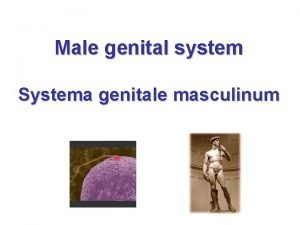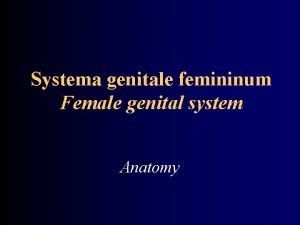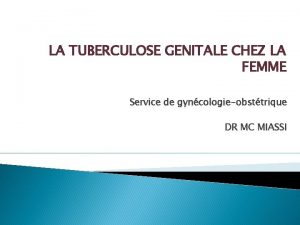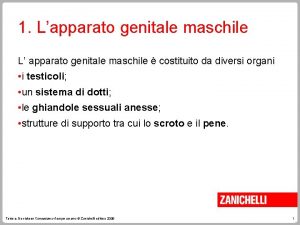Systema genitale masculinum Systema endocrinum M Petrova Male











- Slides: 11

Systema genitale masculinum. Systema endocrinum M. Petrova

Male reproductive system. Anatomical terms ● ● ● testis, m - lat. witness, testicle etymol. scrotum, i, n - the testicle pouch funiculus spermaticus - spermatic cord epididymis, idis, m - etymol. penis, m a. b. c. ● ● ● radix penis - the root of the penis corpus penis - the body of the penis glans penis - the rounded tip of the penis *glans, glandis, f - acorn d. praeputium penis - foreskin of the penis e. corpora cavernosa penis - cave-like structures f. corpus spongiosum penis - spongy-like structure vesicula seminalis - seminal gland click glandula bulbourethralis - bulbourethral gland, Cowper’s gland click prostata, ae, f - prostate gland ductus (vas) deferens - the excretory duct of testis ductus ejaculatorius - ejaculatory duct

Male reproductive system. Term-elements 1. 2. 3. 4. 5. vir, viri, m - man, male human testis, m scrotum, i, n epididymis, idis, m penis, m a. b. 6. 7. 8. 9. 10. glans penis praeputium penis vesicula seminalis prostata, ae, f ductus (vas) deferens semen, seminis, n - seed, seminal fluid spermatozoon pl. spermatozoa , orum *circumcisio, sionis, f - circumcision, surgical removal of the foreskin 1. 2. 3. 4. 5. -ANDR- (o) *gr. aner, andros, m - man, male -ORCH- / -ORCHID- (o) *gr. orchis, idis, m SCROT- (o) EPIDIDYM- (o) PHALL- (o) *gr. phallos a. b. 6. 7. 8. BALAN- (o) POSTH- / PREPUTI- (o) VESICUL- (o) PROSTAT- (o) VAS- (o) 9. = 10. SPERM- / SPERMAT- / SEMIN- (o)

Male repr. system. Pathological conditions ● ● ● crypt-orch-ismus (lat. retentio testis) - hidden testis ; failure of the testes to descend into the scrotum. an-orch-ia = an-orchid-ismus - absence of one of both testes varicocele - varicose veins in the scrotum hydrocele - pathological accumulation of serous fluid in the scrotal pouch seminoma - tumor of the testis arising from sperm-forming tissue phimosis - abnormal constriction of the foreskin that prevents it from being drawn back to uncover the glans penis oligospermia - condition of having less than the normal number of spermatozoa in the semen azoospermia - absence of spermatozoa in the semen aspermatismus - failure to ejaculate or secrete semen priapismus - persistent erection of the penis, as seen in certain pathologic conditions; from name of Priapus, ancient fertility god click) gonorrhoea - gon- seed + rrhoea - flow , secretion - STD caused by a bacterium (Neisseria gonorrhoeae ), involving chiefly the mucous membranes of the genitourinary tract syphilis, idis, f - contagious STD caused by the spirochete Treponema pallidum. More on the curious history of syphilis click

Male repr. System. Urology. Surgical interventions, procedures ● ● ● ● vas-ectomia - male sterilization by surgical excision of the vas deferens vaso-stomia - (literally connection of the vas to the vas) is a surgery by which vasectomies are partially reversed hydrocel-ectomia; varicocel-ectomia - surgical procedure to remove a hydrocele / varicocele orchi-ectomia (bilateralis) - surgical procedure in which one or both testicles are removed (bilateral orchiectomy) orchi-ectomia radicalis - surg. removal of a testis (or both) plus the entire spermatic cord, performed when an onset of testicular cancer is suspected prostat-ectomia partialis / radicalis - partial / radical removal of the entire prostate gland, the seminal vesicles and the vas deferens (performed for malignant cancer) prostat-ectomia retropubica / perinealis - prostatectomy through an incision in lower abdomen/perineum click prostat-ectomia transurethralis - A transurethral resection of the prostate (TURP) is surgery to remove parts of the prostate gland through the urethra. No incisions are needed.

Systema endocrinum

Endocrine glands etc. Term-elements 1. 2. glandula, ae, f *lat. glans, ndis, f - acorn hypophysis, f = lat. glandula pituitaria *pituta - 1. slime, mucus; named so by Vesalius who followed Galen in antiquity described the pituitary gland as part of a series of secretory organs for the excretion of nasal mucus 3. 4. 5. 6. 7. 8. epiphysis, f = lat. glandula pinealis (literally "like a pine cone, "pinus -pine tree) glandula thyroidea - from thyreos "oblong, doorshaped shield" glandulae parathyroideae - four small endocrine bodies in the region of the thyroid gland thymus, i, m - gland near the base of the neck, probably so called because of a fancied resemblance to a bud of thyme glandulae suprarenales - adrenal glands, which lie atop or adjacent to each kidney pancreas, atis, n - from pan- + Gr. kreas, flesh, meat -ADEN- (o) ADEN- gr. gland ; ADENOID- gr. pharyngeal tonsil. 1. 2. 3. 4. 5. 6. 7. -PITUITAR- (o)* *lat. term-element used -PINEAL- (o)* -THYR/ E- (o) / -THYR(E)OID-PARATHYR(E)OID- (o) -THYM- (o) -PANCREAT- (o) *. . . -ISMUS / -IA term ending, used often in endocrinology for dysfunctions in the gland hormone secretions (example: hypercortisolism)

Endocrinology. Pathological conditions ● ● ● ● hyper-pituitar-ismus - increased activity of the pituitary gland, especially increased secretion of growth hormone→ acromegalia; gigantismus hypophysarius) hypo-pituitar-ismus - decreased (hypo) secretion of one or more of the eight hormones normally produced by the pituitary gland (example: decreased vasopressin ADH→ diabetes insipidus - condition in which the kidneys are unable to prevent the excretion of water) pineal-oma - tumor of pineal gland; thymoma - tumor of thymus gland hypo-thyreoid-ismus - underactive thyroid or low thyroid, is a disorder of the endocrine system in which the thyroid gland does not produce enough thyroid hormone; myxoedema another term for severely advanced hypothyroidism hyper-thyreoid-ismus - condition that occurs due to excessive production of thyroid hormones by the thyroid gland→ thyreotoxicosis condition that occurs due to excessive thyroid hormone of any cause and therefore includes hyperthyroidism thyreoid-itis Hashimoto - autoimmune illness in which there is inflammation, followed by destruction and fibrosis of the thyroid gland struma - goiter; refers to any visible enlargement of the thyroid gland; Worldwide, over 90% of goitre cases are caused by iodine deficiency

Endocrinology. Terms ● hypercorticismus - excessive production of adrenal cortical hormones in the body. ● hyperglycocorticismus - increased production of glycocorticoid hormons from the adrenal cortex (cortisol, cortisone, and corticosterone) ● hypercortisolismus - excess levels of cortisol in the blood, connected to Cushing's syndrome - the collection of signs and symptoms due to prolonged exposure to glucocorticoids such as cortisol. ● hyperandrogenia - excessive secretion of androgens (male sex hormones - STEROIDS including testosterone androsterone) ● hyper/hypo. . . -hormone-ISMUS/IA - terms for dysfunctional produce of hormones ● Other conditions associated with endocrinological disorders: *hirsutismus - excessive growth of facial or body hair in women, children *dysphonia - altered voice production (Thyroid dysfunctions)*virilisatio - abnormal development of male sexual characteristics in a female *polydipsia excessive or abnormal thirst (diabetes)*polyphagia - excessive or pathological desire to eat (diab. ) *obesitas = adipositas from the Latin obesitas, which means "stout, fat, or plump"- severe or morbid overweight (diab. type 2)

Diabetes *diabetes, ae, m - literally "a passer-through, siphon, " from diabainein "to pass through". In classical Greek, diabainein meant "to stand or walk with the legs apart, " and diabetes meant "a drafting compass, " from the position of the legs click 1. 2. 3. Diabetes insipidus - literally tasteless; because of the ancient medical practice for tasting the urine and this form of diabetes doesn’t manifest itself with glycosuria click Diabetes mellitus - literally honey-sweet diabetes; It was Thomas Willis who in 1675 added "mellitus" to the word "diabetes" as a designation for the disease, when he noticed the urine of a person with diabetes had a sweet taste (glycosuria). This sweet taste had been noticed in urine by the ancient Greeks, Chinese, Egyptians, Indians, and Persians. a. Type 1 - ab insulino dependens - pancreas's failure to produce enough insulin due to loss of beta cells; referred to as "insulin-dependent diabetes mellitus" (IDDM) or "juvenile diabetes" b. Type 2 - ab insulino independens - begins with insulin resistance, cells fail to respond to insulin properly; referred to as "non insulin-dependent diabetes mellitus" (NIDDM) or "adult-onset diabetes" Diabetes gestationis - diabetes developed during pregnancy

Diabetic complications ● ● ● ● Polyneuropathia diabetica - disease that affects multiple peripheral nerves as complication of diabetes mellitus DM Microangiopathia diabetica- any clinical or pathological changes resulting from small vessel disease in patients with DM Macroangiopathia diabetica - a finding in long-standing DM, characterized by accumulation of lipids and blood clots within large blood vessel walls, obstructing blood flow Retinopathia diabetica - a diabetes complication that affects eyes. It's caused by damage to the blood vessels of the light-sensitive tissue at the back of the eye (retina) Gangraena diabetica - gangrene resulting from arteriosclerosis associated with DM Pes diabeticus - diabetic foot. A foot with a constellation of pathologic changes affecting the lower extremity in diabetics, often leading to amputation and/or death due to complications; the common initial lesion leading to amputation is a non-healing skin ulcer Nephropathia diabetica - the nephropathy - kidney disease, that commonly accompanies later stages of DM; begins with hyperfiltration, renal hypertrophy, microalbuminuria, and hypertension; in time proteinuria develops, with other signs of decreasing function leading to end-stage renal disease (chronic liver failure)
